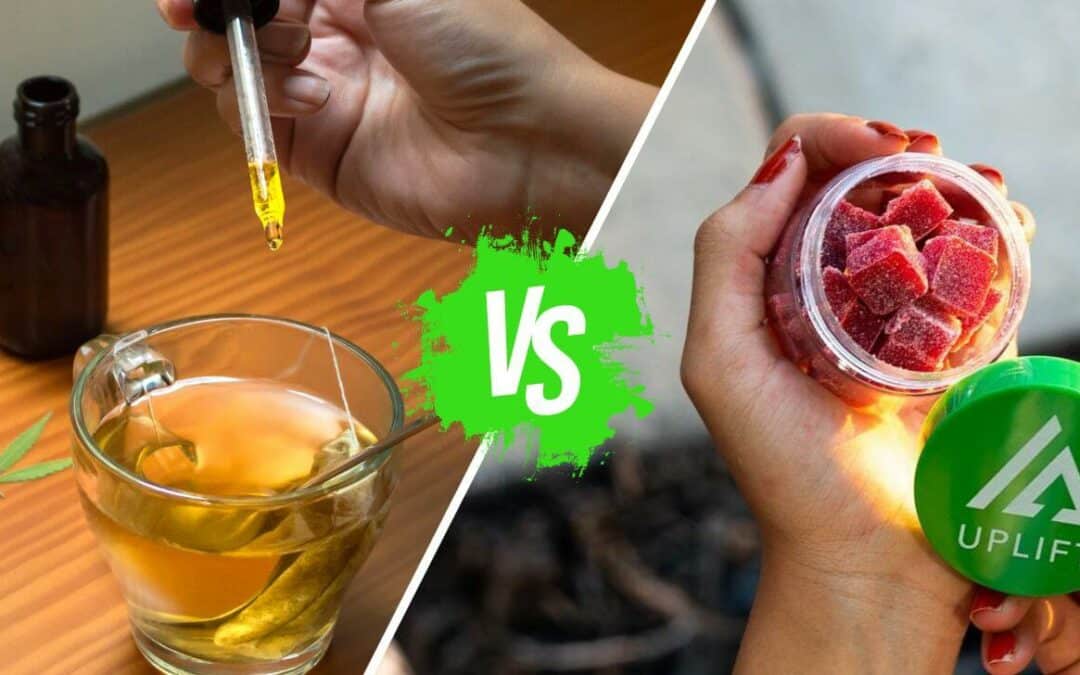Tincture vs edible, which is better? Edibles have been a popular way to consume cannabis for centuries. In recent years, a new cannabis product has emerged – tinctures. While tinctures are often grouped with “edibles”, they have some key differences that may affect your experience as both a medical cannabis patient and a consumer.
This article compares tinctures and edibles. We will compare four major areas to determine which is best:
- Health effects
- Cost
- Convenience
- Enjoyment factor
What Are Edibles?
Edibles refer to food or drink products infused with cannabis extracts or concentrates. They offer an alternative to traditional methods of consuming cannabis, such as smoking or vaping.
Legal dispensaries usually measure the potency of edibles in increments of 5-10mg of either THC or CBD. THC is the psychoactive compound in cannabis that produces the “high” feeling, while CBD is non-psychoactive and is known for its potential health benefits.
It is important to note that the effects of edibles can take longer to kick in than other forms of cannabis consumption, as they need to be digested first. It is recommended to start with a low dose and wait at least 1-2 hours before consuming more, as the effects can be quite potent and last for several hours.
The Pros and Cons of Edibles
Pros
Dosage is precise. Edibles are packaged in pre-dosed packages, making it easier to measure and consume within one’s comfort zone. Typically, each piece contains between 5-10mg of THC or CBD.
Variety of flavors and types. There are a variety of fun edible styles and flavors, such as Blue Raspberry, Orange, Lemon, Strawberry, Cherry, Blue Razz, and Watermelon. Some of the options have CBD blended with other cannabinoids, like CBG or CBN.
Less intimidating. Edibles are a great way for novices to get acquainted with the psychoactive effects of cannabis. It’s more user-friendly than vaping or smoking.
Intense effects. Smoked cannabis enters the bloodstream via the lungs, and is delivered directly to the brain in minutes. Edibles are a good option for users who have a high tolerance.
Easy to access. Edibles are readily available in most states that have legalized medical cannabis. Additionally, edibles offer a discreet way of consuming cannabis without the need for smoking, making them a popular choice among individuals who prefer a more inconspicuous method of consumption.
Duration. The effects of an edible can last between 6 to 12 hours. However, some experts claim that the residual effects can last from 12 to 24 hours.
Reasonable Prices. Due to their affordability, effectiveness, and ease of manufacture, edibles can be found at affordable prices. At Uplift CBD, our Delta 9 chewable costs $10 for a 50MG pack, while our Delta 8 gummies cost $19.99 for a 500MG pack and $29.99 for 1000MG.
Cons
Intense Effects. Due to the fact that they take up to two hours to kick in, some users consume more than necessary, leading to more intense effects than desired. Some microdose products are available, but their variety is limited.
Duration. With lasting effects that last 4 to 6 hours (or longer) and a residual effect of up to 24 hours, edibles may be too much for some users.
Premeasured dose. Some users only need 3mg and splitting up a 10mg edible can make it difficult to get exactly the dosage that you need. If you have a higher tolerance, it may take 100mg to feel any effects. This can be expensive because most states limit the milligrams per package to 100mg.
Start time. The effect of edibles can last anywhere between 30 minutes to 2 hours. Some consumers may find it difficult to predict the effects of edibles, as they may take a dose extra too soon (or need faster relief that an edible cannot provide).
Less predictable effects. Some people do not experience psychoactive effects after eating edibles. It’s a common experience, but it isn’t always realized until many attempts have failed. Many edibles don’t use a specific strain or do not list it, so medical patients might have difficulty finding a product with the desired effects.
Dietary issues. The edibles menu may be difficult to navigate if you have nutritional concerns. Although the menu includes a growing selection of vegan, gluten-free, and non-dairy products, they are still less popular than the high-sugar options such as chocolates, gummies, and baked goods.
What Are Tinctures?
Tinctures can be made from either alcohol or oils infused with marijuana, and they are considered cannabis concentrates. However, many consumers treat tinctures as edibles. Throughout history, tinctures have been used as herbal and medical remedies. The first Western documentation of cannabis-based tinctures appeared in a Medical Journal in 1843.
Consumers can consume tinctures sublingually by placing them under the tongue for 10 to 15 seconds. Tinctures can also be infused into foods or drinks or used topically on skin conditions.
There are several types of tinctures available. Full-spectrum or whole plant tinctures contain all cannabinoids, terpenes, and other compounds found in the given cultivar, including THC, CBD, CBG, CBN, myrcene, caryophyllene, and others. Broad-spectrum tinctures have the same benefits as full-spectrum tinctures but do not contain THC. Isolates are less common because they do not use the entourage effect and only contain a single cannabinoid like THC or CBD.
MCT oils, such as coconut or olive oil, are commonly used to make tinctures. However, some tinctures use alcohol as a solvent, which can be replicated at home using glycerin or alcohol.
The Pros and Cons of Tinctures
Pros
Exact dosages. Tinctures are often packaged with a dropper that allows users to measure their doses. This makes it easier for users to control the exact dosage they consume, which is especially important for medical users who require precise dosing.
Basic ingredients. The majority of tinctures are simply a mixture of MCT oil and cannabis unless they’re flavored. However, some manufacturers may add additional ingredients such as flavorings, terpenes, or other natural herbs and supplements to enhance the tincture’s effects or taste.
More cannabinoids, a variety of ratios. Tinctures are available in pure CBD or pure THC. They can also be formulated with a ratio of cannabinoids, ranging from 1:1 to 30:1, allowing customers to customize their experience.
Tinctures are available in bottles with up to 1,000mg of THC, CBD, and other cannabinoids. The tinctures will last longer depending on how much THC, CBD, and other cannabinoids you want.
Faster onset time. Many users believe that the mucus tissues absorb tinctures more quickly because they place the liquid under the tongue. Sublingual products such as tinctures claim to have effects within 15-30 minutes. We recommend that you wait the full two hours between doses, to give each dose ample time to work. Tinctures are not intoxicating when applied topically.
Duration. Similar to edibles, the effects of tinctures can last 6-8 hours.
Higher concentrations. Tinctures are available in up to 1,000mg of concentration per container. This is ideal for users with higher tolerances and those who want to extend the life of their product.
Cons
Expensive. Due to their higher THC contents, tinctures may be a little more expensive. Some bottles can cost over $100.
Flavor. Unless flavored, most tinctures have an earthy flavor that may not appeal to all consumers.
Duration. For some users, 6-8 hours is too long.
Tincture vs Edible: What Is Healthier?
Compared to edibles, tinctures offer several advantages in terms of health benefits. Firstly, tinctures are less likely to contain any added sugar or allergens, making them a healthier option for those who are mindful of their diet.
Moreover, tinctures often have a more potent concentration of cannabinoids and a full spectrum of benefits, allowing users to experience the entourage effect and achieve the full desired effects of the product.
Overall, tinctures are a healthier and more effective choice for individuals seeking the benefits of cannabinoids without the added sugars and allergens found in edibles.
Tincture vs Edible: Cost Comparison
When it comes to pricing, the cost of edibles can range from $5 to $100, while a typical 100mg package costs around $15. On the other hand, tinctures are usually priced between $30 and $200, which may seem steep at first glance. However, it’s worth noting that many tinctures contain 2-5 times more cannabinoids than edibles, which justifies the higher price for most consumers.
Both edibles and tinctures can last for 6-8 hours, but the storage life differs. Edibles can last up to a year and up to 3-6 months, while tinctures can last up to 10 years.
It’s common for consumers to consume edibles at a rate of 100mg per product, compared to tinctures which usually have a concentration of 1,000mg. Despite the higher cost of tinctures, their higher potency and longer duration make them a more cost-effective option for those seeking maximum benefits. However, for those who are satisfied with the potency and flavor of edibles, they can still provide a great experience at a reasonable cost.
Tincture vs Edible: Which Is More Convenient?
Both edibles and tinctures are easy to use and store, and they can be conveniently transported (but remember not to carry cannabis across state borders). However, instead of creating them at home, it is advisable to encourage readers to purchase them from reputable online stores like Uplift CBD.
When purchasing from an online store like Uplift CBD, it’s important to look for certain factors to ensure that you are buying a quality product. Here are some tips:
- Check the company’s reputation: Look for reviews from other customers and check if the company has any certifications or awards that demonstrate their commitment to quality.
- Check the product’s lab testing: Reputable companies will provide lab testing results for their products, which show the potency and purity of the CBD. This information should be easily accessible on the company’s website.
- Check the ingredients: Make sure the product lists all of its ingredients, and avoid any that contain harmful additives or fillers.
- Check the shipping and return policies: Look for a company that offers free or low-cost shipping and a reasonable return policy in case you are not satisfied with the product.
By following these tips, you can ensure that you are purchasing a high-quality CBD product from a reputable online store like Uplift CBD.
Tincture vs Edible: Enjoyment Factors
The way edibles metabolize within our bodies gives them a stronger high. Edibles also have a wider range of flavors than tinctures, including chocolate and fruit flavors. Tinctures can be unpleasant to taste unless they are flavored.
Sublingually consumed tinctures are said to have effects 2-8 times quicker than edibles, although this has not been proven. Consumers should wait at least 2 hours between each dose to avoid overdosing.
While you can’t really go wrong with edibles or tinctures, edibles are more flavorful and offer a better experience to discerning consumers.
Final Thoughts: Tincture vs Edible
Both tinctures and edibles offer unique benefits for those looking to enjoy the effects of CBD. Tinctures offer faster onset times when consumed sublingually, but edibles offer a wider range of flavors for a more enjoyable experience. Regardless of which method you choose, it’s important to start with a small dose and wait at least two hours before consuming more to avoid overdosing.
If you’re interested in trying CBD, consider giving Uplift CBD a try. Our high-quality CBD products are sourced from organic hemp and third-party lab tested to ensure purity and potency. With a variety of tinctures, edibles, and topicals available, there’s something for everyone.
Order now and experience the benefits of CBD for yourself.
DELTA 8 PRODUCTS WE OFFER


